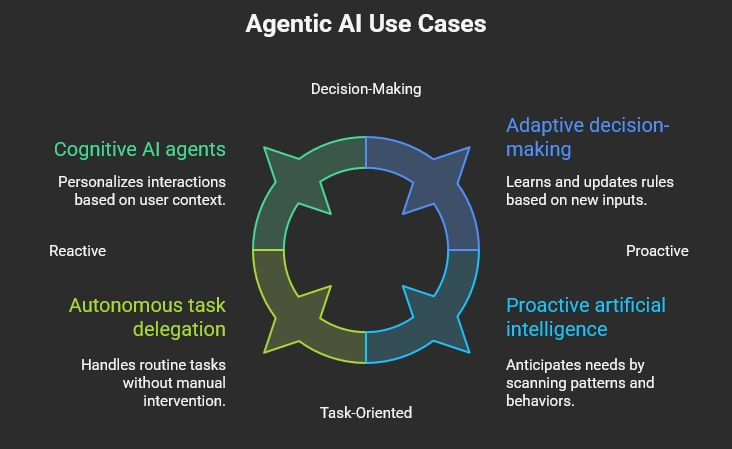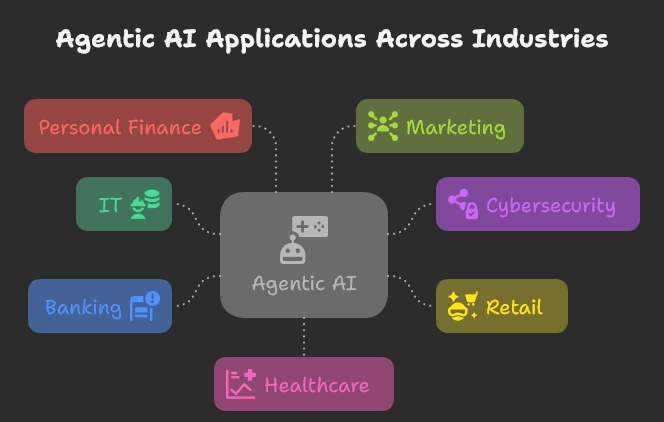Powerful Agentic AI Examples and Use Cases in Action & Why They Matter

Agentic AI isn’t some far-off future. In fact, it’s already powering real results. From Nike solving bad sizing with smart fit tools to Mastercard stopping fraud mid-swipe, brands are using AI agents that do the work, not just suggest it. These systems are now tracking, adapting, following up, and fixing things on their own.
Bottom line? If there's a repetitive task or bottleneck slowing your team down, there's probably an AI agent that can take it off your plate. For good.
Agentic AI completely changes how humans work with machines. These aren’t just regular chatbots; they are more like digital employees with powerful software minds.
Agentic AI understands texts, images, and even sounds, and can plan and execute an entire project on its own. They understand text, images, and even audio, and they adapt in real time.
Take this: You’re prepping for a work trip. Normally, you’d have to book flights, schedule meetings, block your calendar, manage emails, and update your team. Now imagine all of that handled without you lifting a finger.
An AI that books your travel, responds to emails with context, updates your availability across tools, and makes sure every moving piece is in sync. That’s the level of intelligence we’re talking about.
Let’s take a closer look at the Agentic AI examples and use cases.
Agentic AI use cases that are changing how work gets done
We’re well past the stage of AI just answering questions or completing prompts. Today, agentic AI examples and use cases are showing up in real workflows like automating decision-making, coordinating tasks, and even managing other AIs.

Knowing how these intelligent software agents are being used can help you plan how to delegate work to AI, spot opportunities in your own org, and stay ahead of the curve.
So, let's break down how some of the most promising AI agent use cases are already delivering results.
1. Autonomous task delegation
This is just like hiring a digital teammate that handles the grunt work flawlessly. Agentic AI breaks down complex processes into smaller, logical steps and assigns them across systems without needing any manual intervention.
From updating CRMs to scheduling emails and syncing project timelines, this is AI task delegation that runs in the background and keeps things moving forward.
2. Adaptive decision-making in real time
Most automations follow rules. Agentic AI learns and updates those rules on the fly. These adaptive decision-making systems continuously evolve their logic based on new inputs, like a user’s changing spending patterns, workflow habits, or inventory levels.
That means your AI doesn’t just react; it gets smarter every time. For teams in finance, logistics, or ops, it’s like having a strategist integrated into the system.
3. Multi-agent collaboration that mirrors your workflow
Great teams divide and conquer and now, so can your agents. With multi-agent collaboration, you can deploy multiple AI agents that work in sync toward one goal.
For example: one agent segments leads, another crafts the follow-up, and a third updates your CRM. Together, they function like a mini marketing squad, except they never miss a beat, a deadline, or a lead.
4. Proactive artificial intelligence that anticipates needs
This is the difference between “AI that waits” and “AI that watches.” Agentic AI uses proactive artificial intelligence to scan patterns, monitor behavior, and take timely action.
Whether it’s spotting security threats, nudging inactive users, or alerting you to churn signals, these agents act like operational watchdogs, always alert, always aligned to your business goals.
5. Cognitive AI agents that act with context
Context is what makes a recommendation feel right. Cognitive AI agents factor in user behavior, history, and ongoing patterns to offer timely, relevant support.
That’s how they personalise interactions, from suggesting budget cuts based on cash flow dips to reminding you about a task you usually complete on Thursdays.
Now here’s the link: Agentic AI often uses cognitive agents as part of its system. While cognitive agents help understand what's going on, agentic AI goes a step further by deciding and acting on it, without waiting for a prompt.
Want to see this in action? At GrowthJockey, we build agentic AI systems that handle lead flows end-to-end, segmenting, nudging, syncing, so your team can stop chasing and start scaling.
Agentic AI in action: Examples you can learn from
It’s one thing to talk about agentic AI in theory. But it’s only when you see it solving real problems, on live systems, with actual consequences, that it clicks.

These are no longer futuristic hypotheticals. These are intelligent software agents already making workflows smoother, decisions sharper, and teams faster.
Here’s how they are showing up:
Agentic AI in IT
Moveworks’ AI Assistant (formerly HelpBot) is a perfect example of goal-driven artificial intelligence in enterprise IT. Built to remove friction in employee support, it resolves password resets, access requests, and common queries, all without the usual IT backlog.
Instead of routing tickets and waiting on a rep, employees just ask, and the bot acts. It uses natural language understanding and integrates with internal systems to deliver instant solutions. That’s smart AI identifying the need and going into action without hitting pause.
Learn more about how agentic AI is changing the app development space
Agentic AI in cybersecurity
When every second counts, agentic AI becomes a necessity. Darktrace’s CyberAI acts like a digital immune system, constantly learning what’s normal across your network, spotting anomalies, and taking action immediately.
This autonomous AI system can isolate compromised devices, block suspicious access, or trigger alerts without waiting for human approval.
By acting fast, it neutralises threats before they turn into breaches. That’s what makes it agentic. It doesn’t monitor and report, it watches and defends.
Agentic AI in retail
Back in 2019, Nike launched something pretty cool, Nike Fit. It’s a smart tool that uses Agentic AI and augmented reality to help you find your perfect shoe size.
Users scan their feet using a phone, and the system maps 13 data points to build a 3D model. But here’s the agentic part, it then compares that model with product-specific sizing patterns to recommend the best fit for that particular shoe.
There is no guessing, no store visit, and no customer service rep needed. Just scan, decide, and checkout, resulting in fewer returns and better fit satisfaction.
For D2C and e-commerce brands looking to implement similar AI experiences, GrowthJockey builds agentic layers that personalise journeys in real-time, without bloating your tech stack.
Read more about how agentic AI is changing the retail space
Agentic AI in banking
Mastercard’s Decision Intelligence is like a smart assistant for your transactions. Powered by agentic AI, it helps spot fraud before it happens and makes sure genuine purchases go through smoothly in real time.
! Behind the scenes, it runs on a combination of advanced models. A recurrent neural network picks up behavioural patterns over time, like how, where, and when you typically spend.
Meanwhile, transformer models scan large volumes of transaction data to spot unusual links or subtle red flags that would be hard to catch manually.
By combining these approaches, this goal-driven artificial intelligence behaves more like an intelligent analyst than a rigid filter, minimising false declines while catching threats before they escalate.
Check out how agentic AI is revolutionising the insurance and banking space
Agentic AI in personal finance
Bud Financial makes your money feel like it has a mind of its own, in the best way. Using agentic AI, the platform learns your spending habits, tracks income flow, and even picks up on goals like building savings or steering clear of overdrafts.
Then it gets to work, spotting trends, predicting upcoming expenses, and sending timely nudges that actually feel helpful.
It’s a solid example of AI task delegation done right: offloading the mental load of budgeting without needing you to micromanage anything. You stay in control, but with a smart system that thinks ahead for you, not after the fact.
Agentic AI in marketing
At GrowthJockey, we’ve watched lean marketing teams unlock serious momentum using multi-agent collaboration.
With our platform, Intellsys.ai- Data Analysis Tool, we’ve built agentic systems that run like well-oiled teams. Each intelligent software agent handles a specific task, whether that’s lead segmentation, CRM updates, or campaign triggers.
They coordinate, adapt, and operations forward without your team constantly checking in. It's the kind of AI task delegation that gives teams back their bandwidth and makes every touchpoint sharper, faster, and more relevant.
Check out the need of agentic AI in digital marketing space
Agentic AI in healthcare
Mayo Clinic uses agentic AI systems like the Google Cloud-backed AI for radiotherapy planning to streamline cancer treatment prep. Previously, radiation mapping was a time-intensive task for specialists.
Now, the agent scans images, suggests treatment zones, and refines its predictions with every case it reviews. It speeds up turnaround times, reduces error rates, and allows physicians to focus on patient interaction rather than operational minutiae. This is real-world AI agent application where precision and speed save lives.
Read our guide to explore the impact of agentic AI in healthcare industry
What businesses can learn from agentic AI examples and use cases
Reading about Alexa or Nike Fit is cool. But if you're building your own product or process, the real takeaway isn't "wow, that's smart,” it's "what made that work?”
Here’s what these real-world use cases teach us:
-
Start with one bottleneck, not a full transformation: Nike didn’t overhaul retail overnight; they solved one recurring issue: bad sizing. Similarly, look at the small repetitive pain points in your system (returns, ticket triaging, onboarding forms). That’s where agentic AI has the highest ROI early on.
-
Let AI act with context, not without it: By letting agents track cash flow patterns and adapt to user goals, Bud gave users a sense of “someone watching out for me.” This is cognitive AI in action. Ask: Where in your customer journey does context matter? That’s where your agent should start acting, not just reacting.
-
Use multi-agent collaboration to mimic team flows: One agent segments leads. One sends the follow-up. One updates the CRM. Instead of running isolated tools, GrowthJockey built a stack of collaborative AI agents with a shared goal of driving conversions. If you’re using disconnected automations, you’re leaving efficiency (and leads) on the table.
-
Add real-world data to make your AI smarter: Mastercard’s goal-driven artificial intelligence works because it’s trained on massive, diverse transaction data. So, if your AI system isn’t getting smarter, it might not be exposed to enough real variation. Feed it historical data, edge cases, and counterexamples so it can learn to spot patterns before they turn into problems.
Agentic AI worked for these companies because they knew exactly where to point it. Do the same: pick a messy, manual workflow and make that your test bed.
Why agentic AI is your next growth lever
The biggest takeaway from these agentic AI examples and use cases? You don’t need to reinvent your business overnight. Most of the companies you read about, Nike, Bud, Mastercard, started with one friction point and solved it with intelligence, not brute force.
That’s what makes agentic AI powerful: it’s not about replacing teams, it’s about freeing them. The magic happens when you plug AI into a real bottleneck and let it adapt.
At GrowthJockey - Startup Accelerator In India, we help you do exactly that. We incubate and accelerate agentic systems that are built for your workflows, your customers, and your goals. Using our Intellsys.ai platform, we co-create intelligent software agents that actually know what to do next, without hand-holding.
Because at the end of the day, agentic AI isn’t futuristic anymore. It’s working quietly behind the scenes at some of the biggest brands.
Now it’s your turn. Let’s build something that actually thinks.
FAQs on agentic AI examples and use cases
What is an example of an agentic AI?
AI trading bots are where agentic AI gets real. These bots will track market trends and make trades on openings identified by them, sort of like a smart investor who never sleeps.
What are agentic AI systems?
Agentic AI systems are those AI-powered frameworks that can fulfill particular goals with very little supervision. The general idea behind these systems is that they act on their own discretion and achieve goals.
What is the best agentic AI?
Moveworks is built to take employee support to the next level. From handling complex workflows to solving issues on the fly, it’s designed to understand what’s going on, make smart decisions, and get things done on its own.
Is ChatGPT an agentic AI?
Although ChatGPT is quite similar in function to what Agentic AI systems do, but they are not the same. The biggest difference is that Agentic AI doesn’t need human intervention to perform but ChatGPT needs human supervision and is entirely dependent on human oversight.








